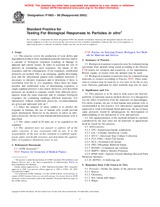Wir benötigen Ihre Einwilligung zur Verwendung der einzelnen Daten, damit Sie unter anderem Informationen zu Ihren Interessen einsehen können. Klicken Sie auf "OK", um Ihre Zustimmung zu erteilen.
ASTM F1903-98(2003)
Standard Practice for Testing for Biological Responses to Particles In Vitro
Automatische name übersetzung:
Standard Praxis für Testing für biologische Reaktionen auf Particles In-vitro-
NORM herausgegeben am 1.11.2003
Informationen über die Norm:
Bezeichnung normen: ASTM F1903-98(2003)
Anmerkung: UNGÜLTIG
Ausgabedatum normen: 1.11.2003
SKU: NS-52030
Zahl der Seiten: 4
Gewicht ca.: 12 g (0.03 Pfund)
Land: Amerikanische technische Norm
Kategorie: Technische Normen ASTM
Die Annotation des Normtextes ASTM F1903-98(2003) :
Keywords:
biocompatibility, growth factors, interleukins, macrophages, nitric oxide, particles, TNF, ICS Number Code 11.040.40 (Implants for surgery, prothetics and orthotics)
Ergänzende Informationen
| Significance and Use | ||||
|
This practice is to be used to help assess the biocompatibility of materials used in medical devices. It is designed to test the effect of particles from the materials on macrophages. For safety reasons, the use of non human, non primate cells is recommended in this practice. For laboratories equipped and approved to work with human blood and tissue, the use of these same protocols would be advantageous for development of understanding of the interaction of cells and particles. The appropriateness of the methods should be carefully considered by the user since not all materials or applications need be tested by this practice. Abbreviations: 4.3.1 LPS—lipopolysaccharide (endotoxin). 4.3.2 LAL—Limulus Amebocyte Lysate. 4.3.3 ATCC—American Type Culture Collection. 4.3.4 FCS (FBS)—Fetal Calf Serum. 4.3.5 NCS—Newborn Calf Serum. 4.3.6 PBS—Phosphate Buffered Saline. 4.3.7 HANKS—A balanced salt solution. 4.3.8 MMPS—Matrix Metallo Proteases. 4.3.9 RPMI 1640—Specific Growth Medium (Roswell Park Memorial Institute). 4.3.10 HEPES—A buffering salt. |
||||
| 1. Scope | ||||
|
1.1 This practice covers the production of wear debris and degradation products from implanted materials that may lead to a cascade fo biological responses resulting in damage to adjacent and remote tissues. In order to ascertain the role of particles in stimulating such responses, the nature of the responses, and the consequences of the responses, established protocols are needed. This is an emerging, rapidly developing area and the information gained from standard protocols is necessary to interpret responses and to determine if there is correlation with the in vivo responses. Since there are many possible and established ways of determining responses, a single standard protocol is not stated. However, well described protocols are needed to compare results from different investigators using the same materials and to compare biological responses for evaluating (ranking) different materials. For laboratories without established protocols, recommendations are given and indicated with an asterisk. 1.2 Since the purpose of these studies is to predict the response in humans, the use of human cells would provide much information. However in the interest of safety in laboratory protocols, the use of non-human and non-primate cells is described. 1.3 The values stated in SI units are to be regarded as the standard. 1.4 This standard does not purport to address all of the safety concerns, if any, associated with its use. It is the responsibility of the user of this standard to establish appropriate safety and health practices and determine the applicability of regulatory limitations prior to use. |
||||
| 2. Referenced Documents | ||||
|
Empfehlungen:
EEviZak – alle Gesetze einschließlich ihrer Evidenz in einer Stelle
Bereitstellung von aktuellen Informationen über legislative Vorschriften in der Sammlung der Gesetze bis zum Jahr 1945.
Aktualisierung 2x pro Monat!
Brauchen Sie mehr Informationen? Sehen Sie sich diese Seite an.




 Cookies
Cookies
